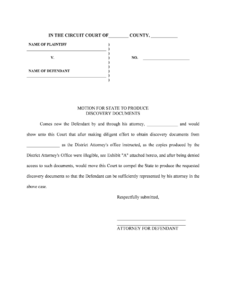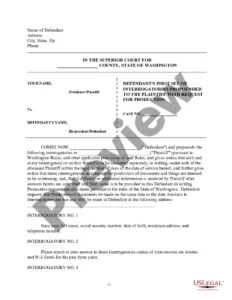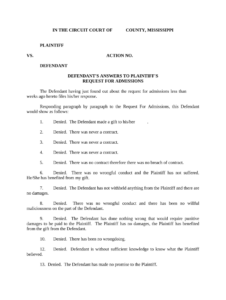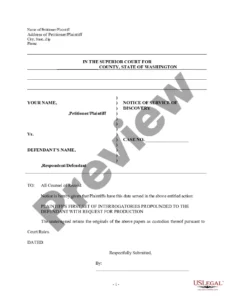Utilizing established models for these requests offers several advantages. It reduces the time and resources spent drafting requests from scratch, minimizing potential errors and ambiguities. This clarity ensures all parties understand the information being sought, promoting smoother cooperation and potentially expediting the discovery phase of legal proceedings. Additionally, using templates helps ensure compliance with court rules and procedures.
The following sections delve deeper into the practical application and construction of these standardized requests, offering practical guidance and examples for various legal scenarios.
Key Components of a Standardized Discovery Request
Effective discovery requests rely on specific components to ensure clarity and completeness. These components work together to define the scope of the request and facilitate a streamlined exchange of information.
1: Identifying Information: This section clearly identifies the requesting party and the party from whom information is sought. Accurate contact information for legal representatives is essential for efficient communication.
2: Specific Definitions: Key terms used within the request should be clearly defined to avoid ambiguity and ensure all parties have a shared understanding of the information being sought. This section may include specific legal terms or industry jargon relevant to the case.
3: Instructions: Clear and concise instructions detail how the responding party should provide the requested information. This includes the format of production (electronic, hard copy, etc.), deadlines, and any specific requirements for organizing or labeling documents.
4: Scope of Request: This section precisely outlines the specific information being requested, including relevant dates, individuals involved, and subject matter. Well-defined parameters prevent overly broad requests and ensure relevance to the legal matter at hand.
5: Categorization: Grouping requests into specific categories, such as documents, electronically stored information, or tangible objects, aids in organization and efficient retrieval of information.
6: Subpoena Information (if applicable): If the request is issued through a subpoena, relevant information regarding the court issuing the subpoena and the case details should be included.
By incorporating these elements, a standardized discovery request promotes clarity, efficiency, and thoroughness in the information exchange process, contributing to a more effective discovery phase in legal proceedings.
How to Create a Standardized Discovery Request
Creating a robust discovery request requires careful consideration of several key elements. A well-structured request ensures clarity, reduces ambiguity, and facilitates efficient information exchange between parties. The following steps outline the process of crafting an effective standardized discovery request.
1: Identify the Parties: Clearly identify the requesting party and the party from whom the information is sought. Include complete contact information for legal representatives.
2: Define Key Terms: Provide explicit definitions for any legal or technical terms used within the request. This ensures a common understanding of the information being sought and minimizes potential misinterpretations.
3: Establish Clear Instructions: Outline specific instructions for producing the requested information, including the required format (e.g., electronic, hard copy), deadlines for compliance, and any specific organization or labeling requirements.
4: Define the Scope: Clearly delineate the scope of the request, specifying relevant dates, individuals, and subject matter. A precisely defined scope ensures the request is focused and avoids undue burden on the responding party.
5: Categorize Requests: Organize requests into distinct categories (e.g., documents, electronic data, physical objects). Categorization enhances clarity and facilitates efficient retrieval and review of information.
6: Incorporate Legal Requirements: Ensure the request adheres to all applicable rules of procedure and legal requirements governing discovery. This may include specific formatting guidelines or limitations on the scope of permissible requests.
7: Review and Refine: Prior to submission, thoroughly review the request for clarity, completeness, and accuracy. Careful review helps minimize potential ambiguities and ensures the request is legally sound.
Through careful attention to these elements, one can construct a discovery request that facilitates a streamlined and effective information exchange, contributing to a more efficient discovery process.
Standardized forms for requesting information provide a crucial framework for efficient and effective legal discovery. Utilizing established models ensures comprehensive coverage of necessary data points while adhering to legal and procedural requirements. This approach streamlines the process, reducing ambiguity and promoting a more cooperative exchange of information between parties. Careful attention to key components such as clear definitions, specific instructions, and well-defined scope ensures requests are both legally sound and practically manageable.
Leveraging these standardized tools contributes significantly to a more efficient and equitable discovery process, ultimately promoting a just resolution of legal matters. Continued refinement and adaptation of these templates to evolving legal landscapes will further enhance their value in facilitating effective information exchange and upholding the principles of fairness and transparency in legal proceedings.



